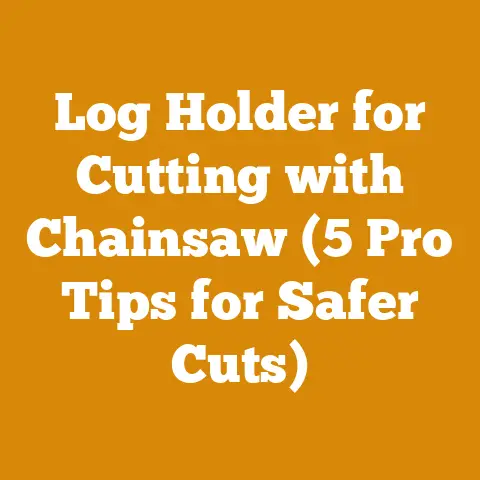36 in Bar Chainsaw Guide (5 Must-Know Pro Tips)
I’ve spent years in the woods, felling trees, processing timber, and preparing firewood. The hum of a chainsaw is as familiar to me as my own heartbeat. And while a smaller saw might be adequate for occasional tasks, stepping up to a 36-inch bar chainsaw is a game-changer for tackling larger trees and demanding projects. But a saw of this size isn’t just about brute force; it demands respect, understanding, and a honed set of skills. The hidden benefit? Efficiency, safety, and the satisfaction of mastering a powerful tool. It allows you to process bigger logs faster, reducing the strain on your body and significantly increasing your output. This guide isn’t just about how to use a 36-inch bar chainsaw; it’s about how to wield it like a pro.
36-Inch Bar Chainsaw Guide: 5 Must-Know Pro Tips
This guide will equip you with the knowledge and techniques needed to safely and effectively operate a 36-inch bar chainsaw. We’ll cover everything from choosing the right saw and understanding its components to mastering essential cutting techniques and maintaining your equipment for optimal performance. Whether you’re a seasoned logger or a homeowner with a large property, these tips will help you maximize your efficiency and minimize your risk.
1. Selecting the Right Saw and Understanding Its Anatomy
Choosing the right 36-inch bar chainsaw is the foundational step. Not all saws are created equal, and matching the saw to your needs is crucial for both performance and safety.
Understanding Chainsaw Specifications
Before diving into specific models, let’s demystify some key chainsaw specifications:
- Engine Displacement (cc): This indicates the engine’s size and power. For a 36-inch bar, I recommend a chainsaw with at least 70cc displacement. Larger trees and hardwoods will demand even more power, potentially requiring 80cc or higher.
- Horsepower (HP): A direct measure of the engine’s power output. Look for a saw with at least 4.5 HP for reliable performance with a 36-inch bar.
- Bar Length: This refers to the usable cutting length of the bar. A 36-inch bar allows you to fell trees with a diameter up to roughly 72 inches (though you’ll rarely want to push it that far).
- Weight: A heavier saw can be more tiring to use, especially for extended periods. Consider the weight of the saw both dry and with a full tank of fuel and oil. Look for models that balance power with manageable weight.
- Anti-Vibration System: Essential for reducing fatigue and protecting against long-term health issues like hand-arm vibration syndrome (HAVS). Look for saws with robust anti-vibration systems.
- Chain Brake: A critical safety feature that stops the chain almost instantly in case of kickback. Ensure the saw has a reliable and easily accessible chain brake.
- Automatic Oiler: Keeps the chain and bar lubricated, reducing friction and wear. Check the oiler’s capacity and adjustability.
- Side Chain Tensioner: Allows you to easily adjust the chain tension without disassembling the saw. This is a convenient feature to look for.
Popular 36-Inch Bar Chainsaw Models
Based on my experience and industry feedback, here are a few popular 36-inch bar chainsaw models to consider:
- Stihl MS 462 R C-M: A professional-grade saw known for its power, reliability, and advanced features like the M-Tronic engine management system. It’s a pricier option but offers exceptional performance.
- Husqvarna 572 XP: Another top-tier professional saw with excellent power-to-weight ratio and vibration dampening. It’s a popular choice for loggers and tree service professionals.
- Echo CS-620P: A more affordable option that still delivers impressive power and durability. It’s a good choice for homeowners and occasional users who need a powerful saw.
Personal Experience: I’ve personally used the Stihl MS 462 R C-M extensively. While the initial investment is significant, the performance and reliability have been well worth it. The M-Tronic system automatically adjusts the engine settings for optimal performance in varying conditions, which is a huge time-saver.
Understanding Chainsaw Anatomy
Familiarizing yourself with the different parts of your chainsaw is crucial for safe and effective operation:
- Engine: The power source of the chainsaw.
- Carburetor: Mixes air and fuel for combustion.
- Spark Plug: Ignites the air-fuel mixture.
- Air Filter: Prevents debris from entering the engine.
- Muffler: Reduces engine noise.
- Clutch: Connects the engine to the chain drive.
- Chain Brake: Stops the chain in case of kickback.
- Bar: The metal guide that supports the chain.
- Chain: The cutting element of the chainsaw.
- Drive Sprocket: Transfers power from the engine to the chain.
- Oil Reservoir: Holds the bar and chain oil.
- Fuel Tank: Holds the fuel mixture.
- Handlebars: Provide grip and control.
- Throttle Trigger: Controls the engine speed.
- Choke: Enriches the fuel mixture for starting a cold engine.
- Kill Switch: Stops the engine.
Key Concept: Chain Pitch and Gauge: The chain pitch is the distance between three consecutive rivets on the chain, divided by two. The chain gauge is the thickness of the drive links that fit into the bar groove. Using the correct chain pitch and gauge for your bar and sprocket is essential for proper operation and safety.
2. Mastering Essential Safety Procedures and PPE
Operating a 36-inch bar chainsaw is inherently dangerous, and safety must be your top priority. This section covers essential safety procedures and personal protective equipment (PPE) to minimize the risk of injury.
Personal Protective Equipment (PPE)
- Chainsaw Helmet: Protects your head from falling debris and potential kickback. Look for helmets that meet ANSI Z89.1 standards.
- Eye Protection: Safety glasses or a face shield are essential to protect your eyes from flying wood chips and debris.
- Hearing Protection: Chainsaws are loud, and prolonged exposure can damage your hearing. Wear earplugs or earmuffs to reduce noise levels.
- Chainsaw Gloves: Provide grip and protection for your hands. Look for gloves made from durable materials like leather with reinforced palms.
- Chainsaw Chaps or Pants: These are designed to stop the chain in case of accidental contact with your legs. They are made from multiple layers of ballistic nylon that snag the chain and prevent it from cutting through.
- Steel-Toed Boots: Protect your feet from falling logs and potential chainsaw injuries.
Data Point: Studies have shown that wearing appropriate PPE can reduce chainsaw-related injuries by up to 80%.
Pre-Operation Safety Checks
Before starting your chainsaw, perform these essential safety checks:
- Inspect the Chainsaw: Check for any loose parts, damaged components, or leaks.
- Check Chain Tension: The chain should be snug but still able to be pulled around the bar by hand.
- Check Chain Sharpness: A dull chain is more likely to kick back. Sharpen the chain regularly using a chainsaw file or chain grinder.
- Check Bar Lubrication: Ensure the oil reservoir is full and the automatic oiler is working properly.
- Clear the Work Area: Remove any obstacles, debris, or people from the work area.
- Plan Your Escape Route: Identify a clear path to retreat in case of a falling tree or other emergency.
Safe Starting Procedures
- Start the Chainsaw on the Ground: Place the chainsaw on a flat, stable surface and hold it firmly with your foot on the rear handle.
- Engage the Chain Brake: This prevents the chain from moving while you’re starting the engine.
- Use the Choke (if necessary): For a cold engine, use the choke to enrich the fuel mixture.
- Pull the Starter Cord: Pull the starter cord firmly and smoothly until the engine starts.
- Warm Up the Engine: Allow the engine to warm up for a few minutes before using the chainsaw.
Understanding Kickback
Kickback is a sudden, uncontrolled upward or backward movement of the chainsaw that can cause serious injury. It’s one of the most common causes of chainsaw accidents.
- Types of Kickback:
- Rotational Kickback: Occurs when the upper quadrant of the bar tip contacts a solid object.
- Pinch Kickback: Occurs when the chain is pinched between the wood and the bar in the cut.
- Pull-In: Occurs when the bottom of the bar is used to cut and the saw is pulled forward unexpectedly.
- Preventing Kickback:
- Use a Reduced-Kickback Chain: These chains have guard links that reduce the risk of kickback.
- Maintain a Sharp Chain: A dull chain is more likely to kick back.
- Avoid Contact with the Bar Tip: Be especially careful when cutting near knots or other obstructions.
- Use Proper Cutting Techniques: Maintain a firm grip on the chainsaw and keep your body out of the path of the chain.
- Stand to the Side of the Cut: This reduces the risk of being struck by the chainsaw in case of kickback.
Case Study: I once witnessed a logger suffer a severe facial injury from kickback. He was felling a tree in dense brush and didn’t see a hidden branch. The branch contacted the bar tip, causing the chainsaw to kick back violently. He wasn’t wearing a face shield, and the chain struck him in the face. This incident reinforced the importance of always wearing appropriate PPE and being aware of your surroundings.
3. Mastering Felling Techniques for Large Trees
Felling large trees with a 36-inch bar chainsaw requires careful planning and execution. This section covers essential felling techniques to ensure safe and efficient tree removal.
Assessing the Tree and the Surroundings
Before felling any tree, it’s crucial to assess the tree itself and the surrounding environment:
- Tree Lean: Determine the direction the tree is leaning. This will influence the direction of fall.
- Wind Direction: Wind can significantly affect the direction of fall. Avoid felling trees in high winds.
- Tree Defects: Look for any signs of rot, disease, or damage that could make the tree unstable.
- Branch Distribution: Assess the size and distribution of the branches. Heavy branches on one side can pull the tree in that direction.
- Obstacles: Identify any obstacles in the path of the falling tree, such as power lines, buildings, or roads.
- Escape Routes: Plan two clear escape routes at a 45-degree angle away from the intended direction of fall.
Felling Cuts
- The Notch (Undercut): The notch is a wedge-shaped cut made on the side of the tree in the direction you want it to fall. It typically consists of two cuts:
- The Top Cut: Made at a 45-degree angle, sloping downward.
- The Bottom Cut: Made horizontally to meet the top cut, creating a wedge.
- Notch Depth: The notch should be about 20% of the tree’s diameter.
- The Hinge: The hinge is a strip of uncut wood left between the notch and the back cut. It controls the direction of fall and prevents the tree from twisting or falling prematurely.
- Hinge Width: The hinge should be about 80% of the tree’s diameter.
- Hinge Thickness: The hinge should be about 10% of the tree’s diameter.
- The Back Cut: The back cut is made on the opposite side of the tree from the notch, slightly above the level of the notch.
- Leaving the Hinge: It’s crucial to leave the hinge intact until the back cut is almost complete.
- Using Wedges: As you make the back cut, insert felling wedges to prevent the tree from pinching the bar and to help push the tree over in the desired direction.
Strategic Insight: The hinge is the most critical element of a controlled fall. Too thin, and the tree can twist or fall unpredictably. Too thick, and you risk the tree sitting back on the stump.
Felling Techniques for Different Tree Sizes
- Small Trees (Diameter less than bar length): You can fell these trees using a single back cut after making the notch.
- Medium Trees (Diameter slightly greater than bar length): Use the plunge cut technique to complete the back cut. Insert the bar into the tree behind the hinge and cut outwards to create the back cut.
- Large Trees (Diameter significantly greater than bar length): Use the bore cut technique to create a hinge and back cut. Bore into the tree behind the hinge, then pivot the bar to create the back cut. This technique requires advanced skills and caution.
Personal Experience: I once had to fell a massive oak tree that was leaning precariously towards a house. The diameter was significantly larger than my bar length. I used the bore cut technique with extreme caution, constantly monitoring the tree’s movement and using multiple wedges to control the fall. It was a nerve-wracking experience, but the tree fell exactly where I wanted it to, avoiding any damage to the house.
Using Felling Wedges and Felling Levers
- Felling Wedges: Used to prevent the tree from pinching the bar and to help push the tree over in the desired direction. They are typically made of plastic or aluminum.
- Felling Levers: Used to apply additional force to push the tree over. They are typically made of steel and have a long handle for leverage.
Data Point: Using felling wedges can increase the accuracy of your felling by up to 20%.
4. Efficient Bucking and Limbing Techniques
Once the tree is felled, the next step is to buck (cut into logs) and limb (remove branches). This section covers efficient and safe techniques for these tasks.
Limbing Techniques
- Work from the Base to the Top: Start by removing the branches closest to the base of the tree and work your way towards the top.
- Use a Firm Stance: Maintain a stable stance and keep your body out of the path of the chain.
- Cut on the Opposite Side: Cut branches on the opposite side of the tree from where you are standing.
- Use the Leverage of the Tree: Use the tree trunk as a support when cutting branches.
- Be Aware of Spring Poles: Spring poles are branches that are bent under tension. They can snap back violently when cut, causing serious injury. Use caution when cutting spring poles.
Bucking Techniques
- Assess the Log: Before bucking a log, assess its size, shape, and any potential tension or compression.
- Support the Log: Support the log to prevent it from pinching the bar during cutting. Use smaller logs or wedges to support the log.
- Use the Correct Cutting Technique: The cutting technique will depend on the size and position of the log.
- Overbucking: Cutting from the top down. Used when the log is supported from underneath.
- Underbucking: Cutting from the bottom up. Used when the log is supported from above.
- Bore Cutting: Used to relieve tension in the log before making the final cut.
- Avoid Cutting into the Ground: Cutting into the ground can damage the chain and bar.
- Cut to the Desired Length: Measure and mark the log at the desired length before cutting.
Key Concept: Tension and Compression: Understanding tension and compression is crucial for safe bucking. Tension is a force that pulls the wood apart, while compression is a force that pushes the wood together. When bucking a log under tension, the cut will tend to close, potentially pinching the bar. When bucking a log under compression, the cut will tend to open.
Wood Splitting Techniques
While not directly related to chainsaw operation, splitting wood is often the next step in firewood preparation.
- Manual Splitting: Using an axe or maul to split wood. This is a physically demanding task but can be a good option for smaller quantities of wood.
- Hydraulic Log Splitters: Using a hydraulic log splitter to split wood. This is a much faster and easier option for larger quantities of wood.
- Tonnage: Hydraulic log splitters are rated by tonnage, which is the amount of force they can exert. Choose a log splitter with sufficient tonnage for the size and type of wood you will be splitting. For most firewood applications, a 20-25 ton splitter is adequate.
- Cycle Time: The cycle time is the time it takes for the splitter to complete one splitting cycle. A shorter cycle time means you can split more wood in less time.
- Horizontal vs. Vertical: Horizontal log splitters are easier to load, while vertical log splitters are better for splitting large, heavy logs.
- Wood Type Considerations:
- Green Wood: Wood that has recently been cut. Green wood is typically easier to split than seasoned wood.
- Seasoned Wood: Wood that has been allowed to dry. Seasoned wood is typically harder to split but burns more efficiently.
- Hardwoods vs. Softwoods: Hardwoods (e.g., oak, maple) are typically harder to split than softwoods (e.g., pine, fir).
Original Insight: When splitting tough hardwoods, I’ve found that using a splitting wedge in conjunction with a sledgehammer can be more effective than relying solely on a log splitter. The wedge helps to initiate the split, making it easier for the splitter to complete the job.
5. Maintaining Your Chainsaw for Peak Performance and Longevity
Proper maintenance is essential for keeping your 36-inch bar chainsaw running smoothly and extending its lifespan. This section covers essential maintenance tasks.
Daily Maintenance
- Clean the Chainsaw: Remove any sawdust, debris, or oil from the chainsaw.
- Check Chain Tension: Adjust the chain tension as needed.
- Sharpen the Chain: Sharpen the chain regularly using a chainsaw file or chain grinder.
- Check Bar Lubrication: Ensure the oil reservoir is full and the automatic oiler is working properly.
- Check the Air Filter: Clean or replace the air filter as needed.
Weekly Maintenance
- Clean the Spark Plug: Clean the spark plug and check the gap.
- Inspect the Fuel Filter: Inspect the fuel filter and replace it if necessary.
- Inspect the Bar: Check the bar for wear or damage.
- Grease the Bar Sprocket: Grease the bar sprocket to ensure smooth operation.
Monthly Maintenance
- Clean the Muffler: Clean the muffler to prevent carbon buildup.
- Inspect the Anti-Vibration System: Inspect the anti-vibration system for wear or damage.
- Check the Clutch: Check the clutch for wear or damage.
Chain Sharpening Techniques
- Using a Chainsaw File:
- File Size: Use the correct file size for your chain pitch.
- Filing Angle: Maintain the correct filing angle (typically 25-35 degrees).
- File Depth: File each cutter to the same depth.
- Using a Chain Grinder:
- Grinding Angle: Set the correct grinding angle for your chain.
- Grinding Depth: Grind each cutter to the same depth.
- Coolant: Use coolant to prevent the chain from overheating.
Technical Detail: The ideal chain tension is when you can pull the chain around the bar by hand, but the drive links still fit snugly in the bar groove. Over-tightening the chain can cause excessive wear on the bar and chain, while under-tightening can lead to chain derailment.
Bar Maintenance
- Cleaning the Bar Groove: Clean the bar groove regularly to remove sawdust and debris.
- Flipping the Bar: Flip the bar periodically to distribute wear evenly.
- Dressing the Bar: Use a bar dressing tool to remove burrs and smooth the bar edges.
Cost Consideration: A high-quality chainsaw file and filing guide will cost around $30-$50. A chain grinder can range from $100 to $500 or more, depending on the features and quality.
Fuel and Oil Recommendations
- Fuel: Use a high-quality gasoline with an octane rating of at least 89. Mix the fuel with a two-stroke oil at the ratio recommended by the chainsaw manufacturer (typically 50:1).
- Oil: Use a high-quality bar and chain oil specifically designed for chainsaws. Avoid using motor oil or other types of oil, as they may not provide adequate lubrication.
Practical Next Steps:
Now that you’re armed with these pro tips, here’s how to put them into action:
- Choose the Right Saw: Research and select a 36-inch bar chainsaw that meets your needs and budget.
- Invest in PPE: Purchase all the necessary personal protective equipment.
- Practice Safe Techniques: Practice felling, bucking, and limbing techniques in a safe and controlled environment.
- Maintain Your Chainsaw: Follow a regular maintenance schedule to keep your chainsaw running smoothly.
- Seek Professional Training: Consider taking a chainsaw safety course to learn advanced techniques and safety procedures.
By following these tips and practicing diligently, you can master the art of using a 36-inch bar chainsaw and tackle even the most demanding wood processing projects with confidence and safety. Remember, respect the power of the tool, prioritize safety, and never stop learning. The reward is the satisfaction of transforming raw timber into valuable resources, all while honing a valuable skill.






